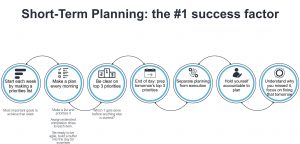Tip 1: Get organised!
The #1 success factor for working from home is planning. Preparing a structure for the day is the best way to drive output, particularly as you adjust to working in a different environment from the office.
Start the week as you mean to go on and set out your most important goals for the week. Then, every morning, write a to-do list for the day ahead – specifically, which tasks need to get done before anything else? It can help to assign a time to each task, but remember to build in a buffer for the unexpected things that can crop up!
As you adapt to your home office, remember to be agile, as some things don’t always go to plan… but that’s okay, as you can still finish the day by preparing your top 3 priorities for tomorrow.

Tip 2: Really focus.
With working from home being the new norm, you may have quickly realised that maintaining focus can be a challenge, particularly if you’re sharing your living space with family and/or pets.
So, once you’ve written your to-do list, there are a few things you can do to make sure you get through it, without any distractions:
- Get clarity on your goals – work with your team to be as clear as possible on what you’re going to deliver, and by when, so you can get much clearer on the ‘how’.
- Work in focused blocks with breaks, with your emails closed down and phone on silent. I recommend using the Pomodoro Technique of 20 minutes of deep focus work and then a 10-minute break.
- Separate deep work and teamwork – interruptions ruin focus so use a closed door, open calendar policy. Have blocks of time where you don’t reply to emails, messages or phone calls.
- Set an alarm – if you have a meeting scheduled, make sure you don’t miss the start time. It’s easy to get too focused in your work and lose track of time.
- Review your performance – hold yourself accountable to your daily plan. If you missed something off, understand why and focus on fixing that tomorrow. You’ll be amazed at how much better you get at doing this in just a few days.

Tip 3: Collaborate and keep in touch with your team, often.
Collaborating and communicating with your team takes on a whole new meaning when you’re working from home. Regular communication is essential to maintaining the flow of information and team effectiveness, so besides the usual methods, here are a few other ways you can keep in touch:
- Asynchronous communication – for communication that doesn’t require an immediate response, Slack and Teams can be great tools to have conversations with multiple people over.
- To schedule meetings, use Zoom, Hangouts or Team for your daily stand-ups, 1-2-1 meetings and weekly team meetings.
- For project work, Trello or Asana are great, as you can see where everything is at, keep the team up to date, and track goals, tasks and owners.
- For month end close, forecasts and other finance rhythms, you can use OneNote or DropBox Paper to collate information and collaborate on a process.

By Oliver Deacon, FSN Modern Finance Forum moderator on LinkedIn, Ex-Microsoft FD and Executive coach
